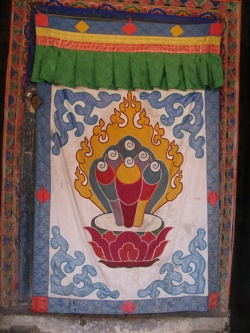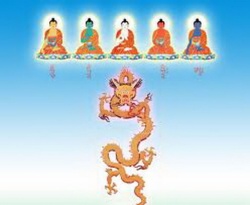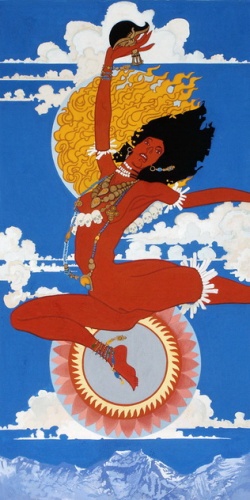Mircea eliade ''from primitives to zen'': kukai’s initiation in the esoteric buddhism
(‘Kobo Daishi Zenshu,’ I, 98 ff.) Kukai (774-835) learned in China and introduced to Japan the Buddhism known as the True Words (Mantrayana in Sanskrit, Shingon in Japanese). In Shingon Buddhism the mysteries are transmitted orally from master to disciple. This Esoteric Buddhism became the most important religion of Heian Japan.The passage printed below is taken from the Memorial Presenting a List of Newly Imported Sutras, which Kukai wrote to the emperor upon his return from studying in China. Kukai wrote reports on the results of his studies and cautiously relates his initiation.
During the sixth moon of 804, I, Kukai, sailed for China aboard the Number One Ship, in the party of Lord Fujiwara ambassador to the T’ang court. We reached the coast of Fukien by the eighth moon, and four months later arrived at Ch’ang-an, the capital, where we were lodged at the official guest residence. The ambassadorial delegation started home for Japan on March 15, 805, but in obedience to an imperial edict, I alone remained behind in the Hsi-ming Temple where the abbot Yung-chung had formerly resided.
One day, in the course of my calls on eminent Buddhist teachers of the capital, I happened by chance to meet the abbot of the East Pagoda Hall of the Green Dragon Temple. This great priest, whose Buddhist name was Hui-kuo, was the chosen disciple of the Indian master Amoghavajra. His virtue aroused the reverence of his age; his teachings were lofty enough to guide emperors. Three sovereigns revered him as their master and were ordained by him. The four classes of believers looked up to him for instruction in the esoteric teachings.
I called on the abbot in the company of five or six monks from the Hsi-ming Temple. As soon as he saw me he smiled with pleasure, and he joyfully said, ‘I knew that you would come! I have been waiting for such a long time. What pleasure it gives me to look on you today at last! My life is drawing to an end, and until you came there was no one to whom I could transmit the teachings. Go without delay to the ordination altar with incense and a flower.’ I returned to the temple where I had been staying and got the things which were necessary for the ceremony. It was early in the sixth moon, then, that I entered the ordination chamber. I stood in front of the Womb Mandala (Garbha Mandala) and cast my flower in the prescribed manner.1 By chance it fell on the body of the Buddha Vairochana in the centre. The master exclaimed in delight, ‘How amazing! How perfectly amazing!’ He repeated this three or four times in joy and wonder. I was then given the fivefold baptism and received the instruction in the Three Mysteries that bring divine intercession. Next I was taught the Sanskrit formulas for the Womb Mandala, and learned the yoga contemplation on all the Honoured Ones.
Early in the seventh moon I entered the ordination chamber of the Diamond (Vajra) Mandala for a second baptism. When I cast my flower it fell on Vairochana again, and the abbot marvelled as he had before. I also received ordination as an acharya early in the following month. On the day of my ordination I provided a feast for five hundred of the monks. The dignitaries of the Green Dragon Temple all attended the feast, and everyone enjoyed himself.
I later studied the Diamond Crown Yoga and the five divisions of the True Words teachings, and spent some time learning Sanskrit and the Sanskrit hymns. The abbot informed me that the Esoteric scriptures are so abstruse that their meaning cannot be conveyed except through art. For this reason he ordered the court artist Li Chen and about a dozen other painters to execute ten scrolls of the Womb and Diamond Mandalas, and assembled more than twenty scribes to make copies of the Diamond and other important esoteric scriptures. He also ordered the bronzesmith Chao Wu to cast fifteen ritual implements. These orders for the painting of religious images and the copying of the sutras were issued at various times.
One day the abbot told me, ‘Long ago, when I was still young, I met the great master Amoghavajra. From the first moment he saw me he treated me like a son, and on his visit to the court and his return to the temple I was inseparable from him as his shadow. He confided to me. ‘You will be the receptacle of the esoteric teachings. Do your best! Do your best!’ I was then initiated into the teachings of both the Womb and Diamond, and into the secret mudras as well. The rest of his disciples, monks and laity alike, studied just one of the Mandalas or one Honoured One or one ritual, but not all of them as I did. How deeply I am indebted to him I shall never be able to express.
‘Now my existence on earth approaches its term, and I cannot long remain. I urge you, therefore, to take the two Mandalas and the hundred volumes of the Esoteric teachings, together with the ritual implements and these gifts which were left to me by my master. Return to your country and propagate the teachings there.
‘When you first arrived I feared I did not have time enough left to teach you everything, but now my teaching is completed, and the work of copying the sutras and making the images is also finished. Hasten back to your country, offer these things to the court, and spread the teachings throughout your country to increase the happiness of the people. Then the land will know peace and everyone will be content. In that way you will return thanks to Buddha and to your teacher. That is also the way to show your devotion to your country and to your family. My disciple I-ming will carry on the teachings here. Your task is to transmit them to the Eastern Land. Do your best! Do your best !’ These were his final instructions to me, kindly and patient as always. On the night of the last full moon of the year he purified himself with a ritual bath and, lying on his right side and making the mudra of Vairochana, he breathed his last.
That night, while I sat in meditation in the Hall, the abbot appeared to me in his usual form and said, ‘You and I have long been pledged to propagate the esoteric teachings. If I am reborn in Japan, this time I will be your disciple.’
I have not gone into the details of all he said, but the general import of the Master’s instructions I have given. [Dated 5th December 806].
Note1 Mandala is a rather complex design, comprising a circular border and one or more concentric circles enclosing a square divided into four triangles; in the centre of each triangle, and in the centre of the Mandala itself, are other circles containing images of divinities or their emblems. During the initiation, the guru blindfolds the disciple and puts a flower in his hand; the disciple throws it into the Mandala, and the section into which it falls reveals the divinity who will be especially favourable to him. On the Symbolism and the Rituals of the Mandala, cf. M. Eliade, Yoga (New York: Bollingen Series LVI, 1958), pp. 219 ff.; G. Tucci, The Theory and practice of the Mandala (London, 196l).
Translation by Wm. Theodore de Bary, in De Bary (ed.), Sources of Japanese Tradition (New York: Columbia University Press, 1958), PP. 144-6. Introductory comment adapted from De Bary, pp. 137 ff. Note by M. Eliade.


